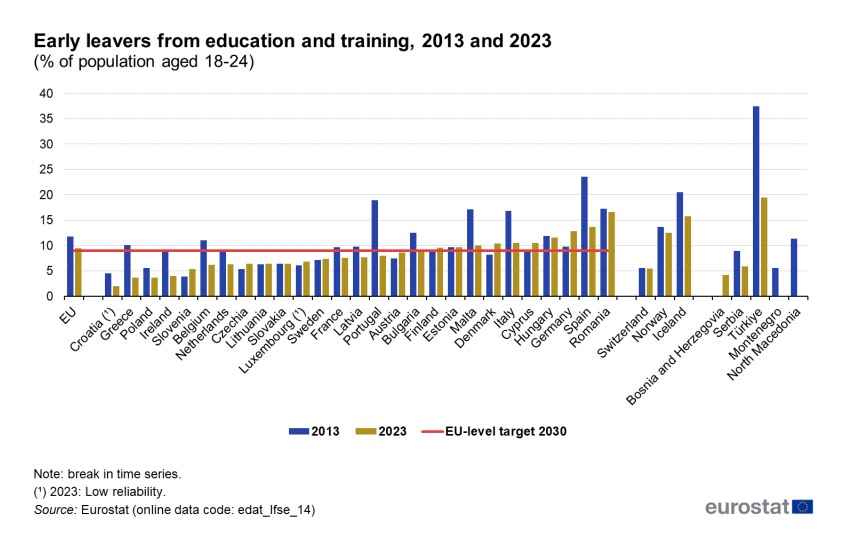Early school leaving, defined in Europe as youths who end education with at most lower-secondary schooling and no ongoing training, has declined across the EU in the past decade. In 2023 the EU’s average rate of early leavers was about 9.5%, down from 13.4% in 2011.

Malta, where a large part of the Axon Park team is based, was historically among the highest in early school leaving. In recent years, Malta has made major strides: the share of young Maltese learners exiting education early fell from 33% in 2005 to 9.5% in 2024. This improvement – one of the fastest drops in the EU – shows Malta’s commitment, yet the rate remains slightly above the EU average and the <9% EU2030 target. Early school leaving carries high individual and social costs (lower earnings, higher unemployment, and greater welfare and justice expenses), so maintaining momentum in reducing it is critical.
Importantly, the reasons why students in the critical Years 7–11 (ages 11–16) disengage and ultimately drop out are complex and multifaceted. Personal or family problems, socio-economic hardships, health issues, and learning difficulties all play a role. However, academic and educational disengagement – students’ loss of interest, motivation, and connection to schooling – has emerged as a primary catalyst for early school leaving in this age group. Disengagement often manifests in negative attitudes toward school, boredom, absenteeism, low achievement, and weak participation, which form a gradual pathway to dropping out. This article examines the latest evidence (2015–2025) on why students become disengaged and leave school early, and it analyzes cutting-edge remedies to re-engage learners. In particular, we focus on methods which have been shown to have the highest impact, particularly gamified, adaptive learning platforms and continuous assessment systems with real-time intervention capabilities. These immersive and AI-powered educational tools are supporting the disengagement problem at its root by making learning more interactive and personalized, and by detecting risk signs early.
Causes of Early School Leaving: Focus on Disengagement
Early school leaving is rarely caused by a single factor; rather, it results from an accumulation of risk factors in a student’s environment. Below we summarize key causes identified in recent research, with a special focus on academic disengagement and related educational factors:
-
Academic Performance and Learning Gaps: There is a strong link between low academic achievement and dropout. A 2019 meta-analysis of 75 studies found that having poor grades and repeated academic failure were among the largest risk factors for eventual school dropout. Students who have significant learning difficulties or who were held back a grade (grade retention) are especially prone to leave school early. Repeated failure often erodes self-esteem and motivation, reinforcing disengagement.
-
Educational Disengagement and Attitudes: Perhaps the most telling precursor of early leaving in secondary school is student disengagement – a loss of connection to the educational process. Many early leavers report that they found school boring, irrelevant, or “not for them.” Research shows that having a negative attitude towards school and low motivation is highly predictive of chronic absenteeism and later dropout. In the EU, students at risk of early leaving often show early signs of disengagement, such as truancy, low class participation, and apathy toward learning. By Year 7–11, disengaged students may skip classes frequently, fail to complete work, and exhibit behavioral problems – all red flags that they are on a path out of school.
-
Socio-economic and Family Factors: Youth from low-income or unstable family backgrounds have higher dropout risk. Poverty, lack of parental support, family crises, or low value placed on education can lead to absenteeism and early exit. Migrant status, rural isolation, or minority background can also compound risk. These external disadvantages often contribute to disengagement by creating stress and lowering expectations.
-
School Climate and Relationships: The school environment itself is pivotal. A negative or unsafe school climate, bullying, and weak teacher-student relationships fuel disconnection. Students who feel anonymous or threatened at school are less likely to engage. Conversely, strong teacher and peer relationships and a supportive climate are protective factors against early leaving.
Evidence: Multiple studies in the last decade underscore the central role of engagement. For example, a large survey of students in Europe found that student engagement (academic, behavioral, emotional) had a strong inverse relationship with dropout risk – students who were less engaged were far more likely to plan on leaving school without completing it. Furthermore, EU policy analyses affirm that school-level factors – like a positive climate, caring teachers, and relevant curriculum – are crucial for keeping learners in school. In summary, while early school leaving has many contributors (poverty, health, family issues), academic disengagement sits at the heart of the problem for ages 11–16. Disengagement often mediates the impact of other factors: for instance, poverty or family issues may lead to disengagement, which in turn causes dropout. Therefore, re-engaging students academically and emotionally in school is key to any effective prevention strategy. As the EU’s Working Group on Schools Policy concluded, a “whole-school approach” that fosters student engagement and well-being is needed to combat early leaving. The next sections explore two of the most effective, evidence-based remedies to boost engagement and prevent dropout: (1) gamified, adaptive learning platforms that personalize education and make it more motivating, and (2) continuous assessment and early warning systems that enable real-time interventions for struggling students.
Interactive Lesson In Axon Park
Gamified and Adaptive Learning Platforms: Re-Engaging Learners through Technology
One of the most promising approaches to address educational disengagement is the use of gamified and adaptive learning platforms. These are digital education systems that incorporate gamification (game-design elements like points, badges, challenges, and instant feedback) and adaptive learning (technology that personalizes content and pace to each student’s ability and progress). The goal is to transform learning from a passive, one-size-fits-all experience into an interactive, fun, and individualized journey – thereby rekindling students’ motivation and engagement.
How Gamification and Adaptivity Help: Gamification taps into young learners’ natural love of games. It provides immediate rewards and feedback, a sense of competition or achievement, and narrative context to academic tasks. This can make learning feel less like “work” and more like play, increasing time-on-task and enjoyment. Adaptive learning algorithms, on the other hand, ensure that material is neither too easy (causing boredom) nor too difficult (causing frustration). By continuously assessing a student’s responses, an adaptive platform can serve up the right level of challenge, give extra support or practice on weak areas, and accelerate progression once mastery is shown. In essence, the platform “meets students where they are,” personalizing the pathway so that each learner stays in their optimal learning zone. This personalization is critical for disengaged students, who often have learning gaps or unique needs that traditional teaching might overlook.
Evidence of Impact: A growing body of research over the past 5–10 years demonstrates that gamified, adaptive learning can significantly improve student engagement, achievement, and reduce dropout rates:
-
Increased Motivation and Participation: Studies show marked gains in motivation when gamification is applied. For example, an experiment found that students in a gamified learning environment were 60% more motivated than peers in traditional classes. Likewise, a survey of secondary students reported that 87% felt more engaged and attentive when lessons included game-like elements. The interactive, goal-oriented nature of gamified platforms combats the boredom and apathy that disengaged students often feel. Teachers frequently observe previously uninvolved pupils becoming active participants when a curriculum is transformed into an educational game or quest. Moreover, gamification appears to boost learning retention: one study noted that learners retained 90% of material learned through gamified activities, versus only 20% retention in a conventional setting. This suggests deeper cognitive engagement is occurring.
-
Improved Academic Performance: Adaptive learning technology has demonstrated concrete improvements in academic outcomes, which can prevent the cycle of failure and withdrawal. At Arizona State University, incorporating an adaptive courseware in math led to more students earning passing grades (A–C) – an 11% higher success rate compared to traditional classes. At Colorado Technical University, blending an adaptive learning (AL) system into face-to-face math courses raised the pass rate from ~75% to 94%, while the course withdrawal rate plummeted from 36% to 17%. Similar dramatic gains were seen in Pre-Calculus (pass rate jumping from 66% to 94%, withdrawals dropping 45% to 13%). These improvements mean far more students stayed on track academically instead of falling behind or dropping the course. A 2021 study summarized that AI-driven adaptive learning systems make education more effective and can lead to fewer dropouts, by tailoring support to each learner’s needs. In primary and secondary settings, this translates to keeping marginal students engaged and progressing, rather than becoming discouraged and leaving school.
-
Engagement and Performance at Scale: Beyond individual case studies, broader implementations have yielded encouraging results. According to a 2020 analysis by Tyton Partners, schools that implemented adaptive learning technologies saw a 30% increase in student engagement on average and a 20% improvement in academic performance compared to traditional instruction. This is a sizable jump, attributed to higher student participation and more efficient learning through personalization. Another review noted that gamification generally correlates with lower dropout rates by making learning interactive, fun, and immersive – thus sustaining students’ interest in continuing their education. A systematic review in 2024 of 90 gamification interventions in primary and secondary education found that gamification is broadly adopted as a strategy to favor school engagement, although it emphasized that designs must address multiple dimensions (not just motivation, but also behavioral and emotional engagement) for maximum effect. The key takeaway is that well-designed gamified, adaptive platforms can re-engage learners who might otherwise drop out.
-
Case Example – Erasmus+ in Malta: Malta has itself explored game-based learning as a tool against early leaving. In 2015, an Erasmus+ project led by the Malta Information Technology Agency (MITA) developed a game-based learning toolkit for secondary schools aimed at “challenging traditional teaching methods” and targeting disengaged students. Educators recognized that early school leaving and lack of student engagement go hand in hand. The project infused subjects like English and Math with ICT and game-like activities to spark students’ interest and encourage them to continue their studies. This initiative reflects a broader awareness in Malta and the EU that innovative, gamified pedagogy can be a protective factor against dropout. Recent research in Spain similarly asked “Could gamification be a protective factor regarding early school leaving?” and concluded that a period of gamified instruction did improve an at-risk student’s engagement and well-being – though the effects waned once the gamification was removed, pointing to the need for sustained application. The lesson is that gamified, adaptive learning should be integrated as a consistent part of the curriculum (not just a one-off novelty) to yield lasting benefits.
In summary, gamified and adaptive learning platforms offer a powerful remedy to academic disengagement. They make learning active, personalized, and rewarding, which is exactly what disaffected 11–16 year-olds need to reconnect with education. These approaches align with best practices identified by educators – e.g. providing a challenging but supportive curriculum, high expectations with immediate feedback, and an engaging classroom experience. By keeping students both motivated and academically progressing, such platforms attack two major risk factors (boredom and low achievement) at once.
Continuous Assessment and Real-Time Intervention: Early Warning Systems
While engaging pedagogy is one side of the equation, the other critical strategy is identifying and supporting at-risk students as early as possible. This is where continuous assessment systems with real-time intervention capabilities come into play. Often implemented as Early Warning Systems (EWS), these approaches use data (academic performance, engagement, behavior indicators, etc.) to monitor student progress continuously and algorithmically flag students showing signs of disengagement or distress. Staff can then deploy timely interventions – for example, extra tutoring, counseling, mentoring, or parent outreach – before a student falls too far behind or drops out. Essentially, it is a shift from reactive to proactive education: rather than waiting until a student fails or leaves, an EWS helps schools predict and prevent dropouts in real time. Importantly, compliance with regulations such as the EU AI Act will dictate how deeply these systems can analyze personal data and guide decisions, so they must be thoughtfully designed to meet privacy, transparency, and fairness requirements—ensuring an equitable environment for every student.
Evidence of Effectiveness: Early warning and intervention systems have a strong track record in various countries, and are endorsed by education experts as a cost-effective dropout prevention tool. Key evidence includes:
-
Widespread Use and Results in High-Income Countries: Early Warning Systems originated in places like the United States, where they have been widely adopted in high schools and even middle schools. They have shown positive results – for instance, many U.S. districts report increased graduation rates after implementing EWS-driven reforms, as more at-risk students were identified and supported in time. These systems are now common in high-income contexts as a proven approach. European education policymakers have also promoted EWS: an EU Council Recommendation in 2011 urged member states to systematically monitor indicators to spot students at risk of early leaving, and to intervene quickly with personalized support. Schools that effectively use data to guide interventions can catch issues (like a student’s disengagement spiral) before they become irreversible. For example, UNESCO and UNICEF note that an EWS is a valuable component in any national strategy to combat dropout, as it directly addresses “the inability of structures and systems to respond to individual and family circumstances” that lead to dropout. By 2020, many EU countries had integrated early monitoring into their policies, with indicators like attendance, behavior, and achievement being used to trigger remedial actions.
-
Targeting Disengagement Signals: Crucially, EWS focus on exactly the early disengagement signals we identified earlier. Poor attendance or truancy is often the first visible symptom of a student’s disengagement, and EWS are designed to detect that quickly. For instance, a spike in absences or repeated skipping of certain classes would immediately raise an alert. Likewise, a decline in grades or failure in multiple subjects – indicating the student is not keeping up academically – would prompt action. By responding to these signs, schools can address the underlying causes (academic difficulty, boredom, personal problems) before the student decides to leave. The European Commission highlights that to tackle early leaving, schools should “diagnose ELET risk factors (e.g. learning difficulties, truancy, illness, peer influence, teacher–student relationships, socio-economic impact)” early and systematically. EWS provides the mechanism to do exactly that. In fact, Malta’s new “ELET Strategy 2023–2030” places developing a national Early Warning System as a central goal, to “monitor and target ELET risk indicators” in real time. This reflects a consensus that early identification of disengagement is critical – and it is one of the practices found to be most effective in preventing ESL across the EU.
-
Quantifiable Impact – Case Studies: A recent large-scale pilot in Guatemala (a middle-income country) provides compelling evidence of EWS effectiveness, even in resource-constrained settings. In a randomized controlled trial covering 4,000 schools, an early warning and intervention program was implemented in 17% of Guatemala’s primary schools. The program, which leveraged existing school staff and simple data tools, achieved a 4% reduction in dropout rates in the critical transition from primary to lower secondary (a 1.3 percentage point absolute decrease) compared to control schools. Among schools that fully complied with the program, dropouts fell by 9%. In high-income countries like Malta, where capacity and technology are greater, one can expect even stronger results from a well-designed EWS. Another example comes from Guanajuato, Mexico, where the state education ministry harnessed big data and AI to create an advanced early warning analytics system. By integrating databases and using predictive modeling on student trajectories, they can now identify students at risk with high precision and involve schools and families in joint monitoring. This data-driven approach has laid the groundwork for effective interventions targeted to each student’s situation, illustrating the potential of AI-enhanced EWS on a large scale.
-
Improving Intervention Outcomes: The true test of an EWS is whether flagged students get the help they need to stay in school. Successful case studies often pair the data system with a strong intervention protocol. For example, in some EU countries, when an EWS alert is triggered, a multidisciplinary team (teacher, counselor, administrator) convenes to review the case and implement supports – be it tutoring in a subject, counseling for mental health, or engaging a community mentor. Early warning data makes this coordination easier by pinpointing who needs what help and when. Over time, schools become better at using their data: one year’s data might reveal, say, that many at-risk students struggled in the transition from Year 8 to Year 9. In response, the school can introduce a summer bridge program, additional course materials, or mentoring for Year 8 students, thus proactively reducing risk for the next cohort. In effect, the EWS not only saves individual students in real time but also informs systemic improvements in school practices.
In summary, continuous assessment with real-time intervention (EWS) directly addresses the fact that disengagement is a process, not an event. It ensures that no student “falls through the cracks” silently. Notably, it was mentioned earlier that one effective practice to prevent ESL is “early-on identification of students’ disengagement” – EWS operationalizes this practice on a broad scale. By investing in robust early warning systems, Malta and other EU states can institutionalize a culture of timely support: catching problems when they are still solvable and before they escalate to a student quitting school. The approach is data-driven and evidence-based, aligning with EU recommendations for coherent strategies to reduce early leaving.

Kids Learning With Axon Park
Conclusion and Recommendation: Gamified, AI-Powered Education to Reduce Early Leaving
Early school leaving in Malta and across Europe is fundamentally an engagement challenge. Students who leave by age 16 often do so after years of disengagement, low achievement, and unmet needs. To break this cycle, innovation in the learning process and in student support systems is paramount. The evidence reviewed in this report strongly indicates that gamified, AI-powered learning platforms and continuous assessment early warning systems are among the most effective investments to combat early school leaving:
-
Addressing Root Causes: These solutions directly tackle the root academic causes of dropout – boredom, lack of motivation, and falling behind. Gamified and adaptive platforms make learning compelling and personalized, pulling students into active engagement and giving them achievable goals. Continuous assessment systems ensure struggling students are spotted and helped before they lose hope. Together, they form a powerful one-two punch: keep students interested in school day-to-day, and catch anyone who starts to slip through the net. This aligns with the EU’s call for evidence-based, comprehensive policies attacking all dimensions of early leaving.
-
Proven Efficacy and ROI: We now have concrete data that these approaches work. From 50%+ improvements in course pass rates when adaptive learning is implemented, to double-digit gains in motivation and retention through gamification, to measurable reductions in dropout rates with early warning systems – the case for efficacy is compelling. Moreover, these interventions are cost-effective. Technology-based solutions scale well: once a platform or system is developed, the marginal cost of adding another student is low. Consider the cost of a student dropping out – in Malta, as elsewhere, early leavers are more likely to be unemployed or in low-skilled jobs, drawing on social services instead of contributing to the economy. Every student retained through graduation boosts the skilled workforce and reduces long-term social costs. Investing in prevention yields dividends for decades.
-
Alignment with Malta’s Strategy and EU Priorities: Supporting gamified, AI-driven education aligns perfectly with Malta’s One Device Per Child (ODPC) and ELET Strategy 2023–2030, which emphasizes quality education, reducing low achievers, and developing an Early Warning System. It also resonates with the EU’s broader Pathways to School Success initiative, which stresses ensuring all learners attain basic skill proficiency and minimizing early leavers through innovative practices. The proposed investment would not be starting from zero – it would build on ongoing efforts (such as Malta’s past Erasmus+ projects on game-based learning, and the planned EWS in the national strategy) and take them to the next level with robust, scalable platforms. An EU funding body can be confident that such an investment addresses both national and European policy goals, making it a model of “EU value-added.” Indeed, a successful rollout in Malta of AI-powered engagement and monitoring tools could be scaled or replicated in other member states facing similar challenges, from Southern Europe (which has historically higher ESL rates) to any region keen on modernizing education.
-
Gamified AI Platforms + EWS = A Comprehensive Solution: It is worth highlighting how these two interventions complement each other. A gamified adaptive platform keeps a higher percentage of students engaged and learning effectively, reducing the overall pool of at-risk students. Meanwhile, the EWS component catches the students who, despite general engagement efforts, begin to disengage due to outside factors or personal issues. The platform itself can collect valuable data for the EWS (for example, detecting when a student hasn’t logged in, performs abnormally poorly, or exhibits disengagement in the learning activities). This integration of real-time learning analytics with early warning intervention creates a seamless, continuous feedback loop in the education system. Teachers and administrators are empowered with actionable insights, and students receive help in a timely manner. This kind of AI-driven, data-informed ecosystem is precisely the innovation needed to drastically reduce early school leaving. It leverages technology not to replace educators, but to augment their ability to personalize support for every learner – which is something even the best-intentioned teachers struggle to do with large classes and limited time.

Axon Park ODPC
Why Should We Do This Now?
The timing for an initiative on this scale could not be better. Malta’s recent rollout of the One Device Per Child (ODPC) program means that virtually every student in Years 7–11 will have reliable access to a laptop, eliminating a major barrier to deploying digital learning solutions at scale. Simultaneously, advances in AI-driven content generation (as exemplified by platforms like Axon Park) now allow educators and curriculum designers to produce large volumes of high-quality, learning-outcome–aligned gamified modules much more quickly. This convergence of universal device availability and rapid, AI-powered content creation presents a rare window of opportunity: we can launch an engaging, personalized digital learning ecosystem immediately, without the years of infrastructure build-out previously required. By seizing this moment, Malta can accelerate its progress toward and beyond the EU’s ESL target, demonstrating how cutting-edge educational technology—deployed when the ecosystem is primed—delivers transformational impact for students, schools, and society at large.
In conclusion, we believe that a focused investment in developing and deploying gamified, adaptive learning platforms coupled with an Early Warning System (particularly in junior high/secondary levels) can have a substantial positive impact on the reduction of early leavers. Such an initiative could involve procuring or building a state-of-the-art platform (in collaboration with educational technology providers like Axon Park or EU digital education programs), developing a large volume of learning outcome-aligned gamified content, training teachers to integrate digital tools into their teaching, and establishing data dashboards for early warning alerts accessible by schools and the Ministry. We also suggest incorporating a robust evaluation component – for instance, a 5-year longitudinal study to measure impacts on student engagement, achievement, and dropout rates, thus contributing to the research base. Given Malta’s relatively small size and recent success in reducing early leavers, an infusion of innovation now could realistically push the rate well below the 9% target and position Malta alongside Croatia, Greece and Poland as having one the lowest ESL rates in Europe (if not THE lowest), as well as set an example for other countries on the global stage. The broader European community would undoubtedly take notice of such a success.
Ultimately, an engaged student is a retained student. By integrating gamified, adaptive learning with real-time support systems, Malta, and EU member states facing similar challenges, can strengthen student engagement, improve academic outcomes, and drive down early school leaving in a cost-effective, scalable way. The infrastructure is now in place across much of Europe, with ODPC initiatives and cutting-edge platforms like Axon Park which are capable of rapidly producing curriculum-aligned content, so the focus must shift to rollout and teacher integration. Backed by clear evidence of impact and aligned with EU and national education targets, this approach represents a pragmatic investment in securing the future of schooling across Europe.





